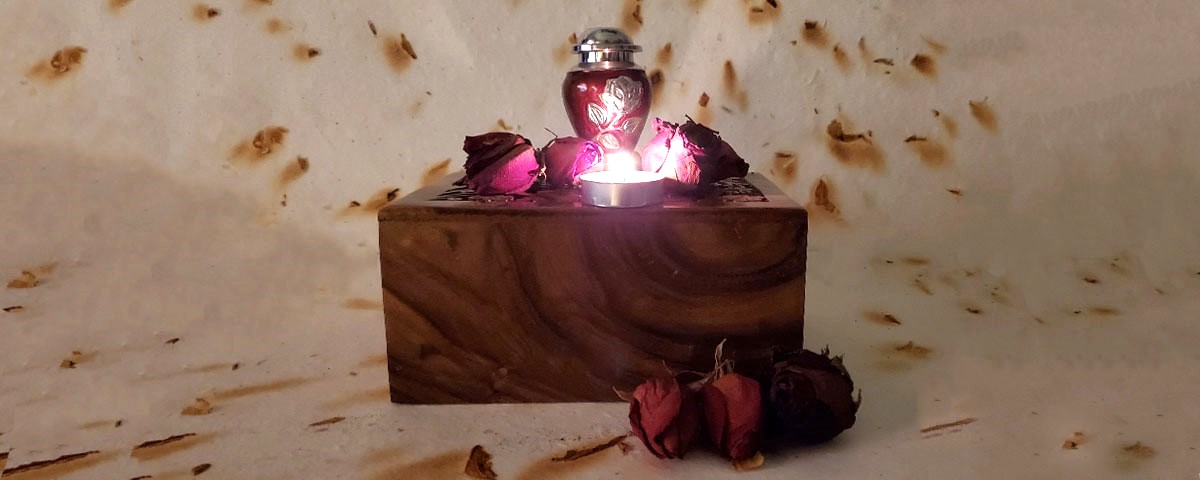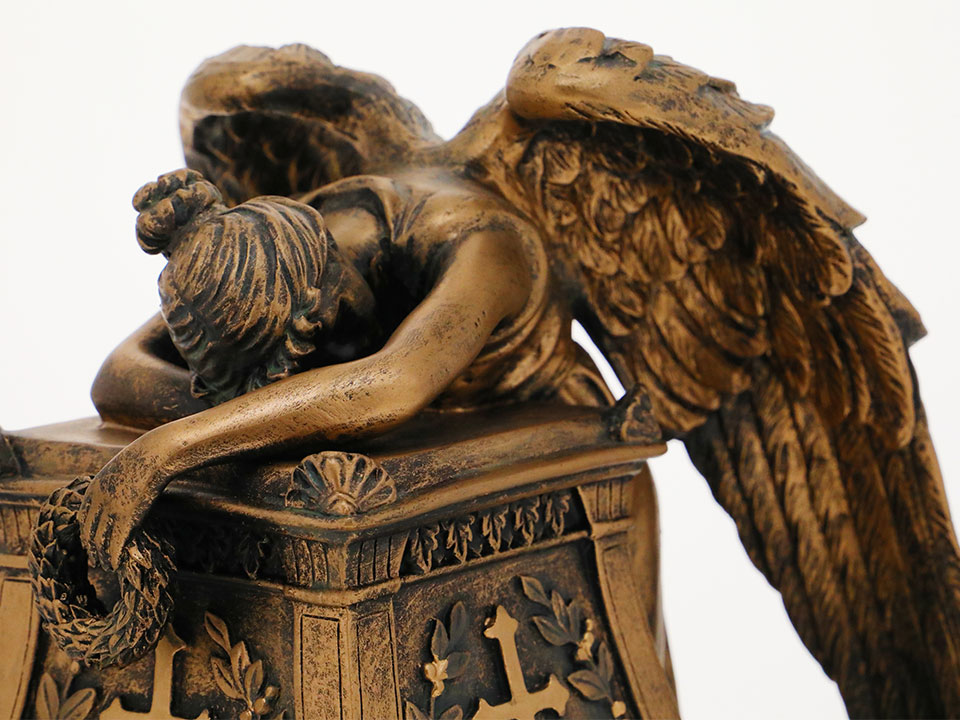When you make a plan for the final remains of a loved one, or while planning for your own services after you pass, you may consider cremation. Cremation is the most popular option in the United States and Canada. If you haven’t known anyone who was cremated, or if you’re just learning more about the topic, you might wonder about how it works. With this guide, you’ll understand what happens during cremation, each step of the cremation process, and how you can make a decision for yourself or a loved one.
What Is Cremation?
Cremation is a process that starts with a deceased intact body and ends with a small amount of cremated remains. The process acts to speed up the rate of decomposition, through the use of water and chemicals or heat. Traditional cremation involves placing the body in a chamber inside a crematorium, and raising the temperature to a high level.
The crematorium is a large piece of equipment that can hold one or more bodies in separate chambers, with an industrial furnace running on fuel like propane or natural gas. Once the body has been reduced to bones, the operator can remove the remains and transfer them to another device for processing.


By comparison, alkaline hydrolysis uses water and chemicals to help dissolve the soft tissues until only bone remains. Some experts argue that this technology, sometimes called water cremation, is more efficient and creates less harmful byproducts to the environment. Since alkaline hydrolysis is a newer technology, it may only be available in a few states.
Key Takeaway:
Cremation is an alternative to burial that has become the default option in the United States and Canada. The process of cremation uses heat, or water and chemicals, to speed up the rate of decomposition and reduce a body to a small amount of cremated remains.
How Common Is Cremation?
Cremation has become the default option in most parts of the United States and Canada. The Cremation Association of North America notes that, as of 2022, about 59 percent of people chose cremation in the U.S., compared to nearly 75 percent in Canada. CANA estimates that these numbers will continue to increase over the next few years, to 65 percent in the U.S. and about 79 percent in Canada.
Worldwide, these numbers sit in the middle of global cremation statistics. Nonprofit World Population Review notes that Japan has the highest rate of cremation, at nearly 100 percent. By comparison, in France, less than 40 percent of people chose cremation in 2019.
What Does the Cremation Process Involve?
1. Conduct a Funeral or Memorial Service (Optional)
If you choose to have a funeral or memorial service, you may conduct this ceremony before the cremation. Make sure to notify the funeral home or crematorium that will be performing the cremation for you. They may offer certain services to prepare the body for the service, including embalming and other tasks. If you prefer, you can usually rent a casket for this purpose.
2. Prepare the Body
Before starting the cremation, the crematorium will perform a series of steps to prepare the body for the process. This includes:
- Asking the next-of-kin to identify the body and confirm that the body is the right person
- Removing exterior items that can’t be cremated, such as earrings
- Taking out internal items that can’t be cremated, like a pacemaker or radioactive implant
- Placing the body into a rigid, sealed container, although some crematories allow for the placement of a body without the container
These steps may take a few days, depending on the crematorium and the number of bodies they need to cremate.
3. Cremate the Body
During a traditional cremation, the operator places the container into an individual chamber. At this time, the operator can turn on the heat to 1,400 to 2,000 degrees Fahrenheit. The time needed to cremate a body depends on the size of the body, the heat and efficiency of the crematorium, and other factors. Small bodies may take a half-hour or less, while larger bodies take up to 3 to 4 hours. Once the body has been reduced to bone, the operator sweeps the remains into a tray to cool for the next step.
4. Process the Remains
At this point in the process, the remains look like large bone fragments, small pieces of bone, and dust. An employee takes the remains, verifies that the tag matches with the person’s name, and places the remains inside a cremulator. Cremulators may use a variety of equipment to break apart the remains into sizes no more than an eighth of an inch in diameter. Some use a blade that spins very fast, while others may use pressure. These differences account for the unique quality of remains from one person to another. Some cremated ashes resemble fine gravel, while others look like soft sand.
5. Collect the Remains
Once the remains have gone through the cremulator, a crematorium employee takes the remains and carefully sifts them to confirm that there are no large pieces of bone. If the remains meet guidelines, they can pour the ashes into a container and place the identification tag with the remains. At this point, they can transport the container to the funeral home or notify the family to prepare to get their loved one’s remains.
Key Takeaway:
To prepare for a traditional cremation, exterior items such as earrings and internal items such as pacemakers will be removed from the deceased, and the body may be placed into a sealed container. When ready, the body is placed in a cremation chamber, where temperatures will be raised to 1400-1800° F. Once the body has been reduced to bone, the remains will be transferred to a cremulator that further breaks them apart until the remains become particles resembling fine gravel or soft sand. These remains are referred to as ashes.
How Much Does Cremation Cost?
Cremation costs $400 to $7,000 or more, depending on the services you choose. As of 2021, the National Funeral Directors Association noted that cremation prices run about $7,000, including a memorial service. The organization offers the following breakdown of pricing:
- Basic services: $2,300
- Cremation: $350
- Preparing the body: $1,000
- Facilities: $1,000
- Transportation: $500
- Cremation casket: $1,300
- Urn: $300
Direct cremation often costs much less, depending on the services you choose and your state. Choice Mutual lists an average of about $2,300 for a direct cremation, which usually does not involve renting the facility for a memorial or paying for services like embalming. In some areas, you may pay as little as $400.
Funeral Rule: When you plan for a cremation, the FTC requires that the funeral home or crematorium give you a detailed list of services and what the services include. You have the option to decline services if they do not apply to your plans.


How Do I Decide Between Burial and Cremation?
When you consider your own final rest or that of a loved one, you’ll need to decide between a traditional burial and cremation. For many people, the lower cost of cremation and the difficulty of finding a burial plot makes cremation the more sensible choice. The NFDA estimates about $9,500 for the cost of a funeral and traditional burial, which usually does not include the cost of the burial plot.
Many people think that traditional burial is a better choice, to meet their religious beliefs or to give them a permanent place to visit a loved one. Some families simply think that burial is better because they understand it, while cremation is unfamiliar. In either case, you should look at both options and go with the one that feels right for you.
Burial Plots for Traditional Burial or Cremation
When you get an estimate for funeral or memorial services, you should know that they may not include the price to buy a burial plot and headstone. You may need to arrange for this service separately. Choice Mutual estimates that you’ll pay $1,000 to $5,000 for a single or companion plot for a traditional burial, plus about $1,000 for a headstone. By comparison, you may pay $350 to $3,000 to get a plot or columbarium niche for an urn. As a general rule, smaller spaces cost less, which explains how burying an urn can cost much less than burying a casket.
What Are Religious Views on Cremation?
Although cost may be the primary driver in families’ choice to have a loved one cremated, religion can introduce complication to the decision-making process. Changing trends have led several major religions to reconsider their positions and issue more recent recommendations to their members. If you’re unsure of your religion’s beliefs toward cremation, you should consult your religious leaders for current guidance.
Catholicism
The Roman Catholic Church has never been a fan of cremation, but it has made some steps toward allowing families who choose cremation to have a proper Catholic burial. In 2016, the Vatican issued guidance saying that people can choose cremation, but they must bury the remains in a cemetery. Anything else, including scattering the ashes or burying remains at sea, would be sacrilegious.
Judaism
Judaism has several sects with unique perspectives on Jewish law, but they trend toward the same views on cremation. Specifically, cremation isn’t necessarily banned for Jewish people, but rabbis of each movement generally recommend that Jewish families choose a traditional burial whenever possible. Performing funeral ceremonies for a person who will be cremated, or burying cremated remains in a Jewish cemetery, remains the decision of the individual people in charge.


What Should I Do With Cremated Remains?
Once you collect the ashes from the funeral home or columbarium, you can figure out what to do with them. For some people, this spawns opportunities for wonderful creativity. You can bury them, scatter them, bury them at sea, or make other choices. Even if you have no clue where to start, you have plenty of time to make a decision. Cremains don’t spoil or disintegrate.
Cremation Urns
Cremation urns offer the most traditional option for keeping the remains of your loved one. In the past, they usually came in metal, wood, or ceramic. These days, you can choose glass, biodegradable materials, and plenty of classic choices. You’ll find urns for ashes in varying sizes and styles, small enough for infants or large enough for the largest adults. Make sure to consider your plans for the urn, including:
- Burial
- Placement in a cemetery’s columbarium
- Scattering
- Water burial
- Placement at home
Although you can choose something plain and traditional, you can also shop for urns that go with a person’s favorite hobbies, distinguished career, and other themes.
Keepsake Urns
Keepsake urns make it easy for you to put an urn in a smaller space, or have plenty of ashes that you can divide among family members and friends. At a smaller size and lower cost, keepsakes turn into great gifts at a memorial ceremony, or as a gift at the loved one’s favorite holiday celebration. You can shop for keepsakes in various sizes, including:
- Smaller versions of full-size urns
- Scattering tubes
- Ornaments
You can also buy a keepsake as an urn for an infant or small child, depending on the capacity.
Cremation Jewelry
Cremation jewelry creates an excellent way to hold a loved one in your heart or your hand. Cremation jewelry comes in styles that you expect from quality jewelry, made of stainless steel, gold, and silver. You can find affordable options that work for every member of your family, or save up for a special piece.
Burial Urns and Urn Vaults
Although you don’t have to choose a traditional burial for cremated remains, you may opt for it for a variety of reasons. To bury ashes, you’ll need an urn that is suitable for burial and an urn vault. Typically, you can choose an urn made of metal, stone, or wood, with an urn vault that may hold multiple urns.
Alternatives
If your loved one wanted a truly unique or unusual sendoff, you can choose from these alternatives:
- Scattering: Be sure to follow guidelines, especially if you want to scatter the ashes in a public place or another person’s private land
- Burial at sea: Find out the rules for scattering or burying the ashes on the specific body of water, which might involve choosing a specific location or hiring a service
- Placement in a memorial reef
- Launching remains into space
Key Takeaway:
Ashes may be placed in cremation urns, keepsake urns, or cremation urn jewelry. They may also be traditionally buried, scattered, buried at sea, placed in a memorial reef, or launched into space.
Start Planning a Final Rest for Your Loved One
Planning for the final rest of a loved one can be an exhausting task, but it could also be engaging and even exciting to make new choices. Taking care of your loved one for the last time is a labor of love, and you can do it with honor when you choose cremation. By understanding the process, you can determine which path is appropriate for your family and your loved one. Even if you choose cremation to keep costs down, as many people do, you have a wide variety of options for the final rest. You can also give yourself a way to move forward, while keeping your loved one close to your heart.
Is a funeral or memorial service required?
You don’t have to perform a funeral or memorial service before having a loved one cremated. If your loved one wanted a ceremony at a local religious institution, you should talk to the institution to find out their policies about services before or after cremation.
Can I rent a casket for a memorial service?
Most funeral homes offer caskets for rent. You may be able to choose from a selection of caskets, at a lower price than you’d pay to buy a casket for a traditional burial. In this case, the body would be moved to a temporary container after the service, prior to the cremation.
Can I watch the cremation?
In most cases, you can watch certain aspects of the cremation if you would like. Generally, the crematorium closes chambers to increase efficiency and speed for the cremation process. You can watch them place the body inside the chamber, close the chamber, and use heat to process the remains.
How much ash will there be?
For the average adult, you can expect to receive about 4 to 6 pounds of ashes, about the size of a small shoebox. If you want a better estimate, you can use our cremation ash estimator to get more information.
What will the ashes look like?
Cremated ashes vary in appearance. Some pieces are so small that they look like dust, sand, or ash. Others will be a bit larger, more like small pieces of gravel. They tend to be a light gray or off-white in color.
MEET THE FOUNDER
Susan Fraser
Susan Fraser, founder of In the Light Urns, Inc., has spearheaded innovation in the memorial industry since 2001. After a personal tragedy, she began creating custom cremation urns for ashes that reflect a lost loved one's individuality. Susan's commitment to comfort makes her an authority on cremation and memorials, guiding and consoling families through understanding and compassion. With expertise and dedication, Susan's cremation guides give families invaluable resources for informed decisions.


Cremation Education
Cremation education informs diverse practices and ethics, empowering informed end-of-life choices.







